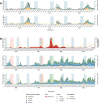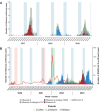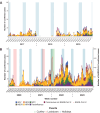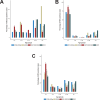Shifts in Respiratory Virus Epidemiology on Reunion Island From 2017 to 2023: Impact of COVID-19 Pandemic and Non-Pharmaceutical Interventions
- PMID: 40040473
- PMCID: PMC11880683
- DOI: 10.1111/irv.70075
Shifts in Respiratory Virus Epidemiology on Reunion Island From 2017 to 2023: Impact of COVID-19 Pandemic and Non-Pharmaceutical Interventions
Abstract
Background: The COVID‐19 pandemic has reshaped the landscape of respiratory viral infections globally. This study examines these changes on Reunion Island, a French department in the southeastern Indian Ocean.
Methods: Retrospective data from 2017 to 2023, from over 24,000 samples collected across the hospital system, partner laboratories, and a network of sentinel physicians, were analyzed and correlated with the number of consultations at the hospital emergency department and with sentinel physicians for symptoms of acute respiratory infections (ARIs). The epidemiology of respiratory viruses was analyzed by comparing the pre‐ and post‐COVID‐19 periods to assess disruptions in seasonal patterns, changes in virus prevalence, and the affected age groups.
Results: Our database effectively captured the epidemiology of respiratory infections across the island, as demonstrated by its strong correlation with the number of consultations for ARI. Post‐COVID‐19, the influenza virus exhibited multiple epidemic waves within a single year, deviating from its traditional single annual peak and showing a significant decline in circulation from 2020 to 2023. The circulation of respiratory syncytial virus was also impacted post‐COVID‐19, with epidemics starting earlier and lasting longer compared with pre‐COVID‐19 years. Human rhinovirus circulated more prominently in the post‐COVID period, accounting for up to one‐third of positive cases, becoming the most prevalent respiratory virus (excluding SARS‐CoV‐2).
Conclusions: These findings suggest a notable impact of the COVID‐19 pandemic and associated NPIs on respiratory virus circulation on Reunion Island since mid‐2020. They underscore the complex interplay between viral interference, public health interventions, behavioral changes, and youth immunity, emphasizing the need for adaptable strategies in managing respiratory virus outbreaks in the post‐COVID‐19 era.
Keywords: COVID‐19; Reunion Island; SARS‐CoV‐2; epidemic; human rhinovirus; influenza; non‐pharmaceutical interventions; respiratory syncytial virus; respiratory viruses.
Conflict of interest statement
The authors declare no conflicts of interest.
Figures





References
-
- SPF , “COVID‐19: Point Épidémiologique à La Réunion du 7 Janvier 2021,” (2021), https://www.santepubliquefrance.fr/regions/ocean‐indien/documents/bullet....
MeSH terms
LinkOut - more resources
Full Text Sources
Medical
Miscellaneous

